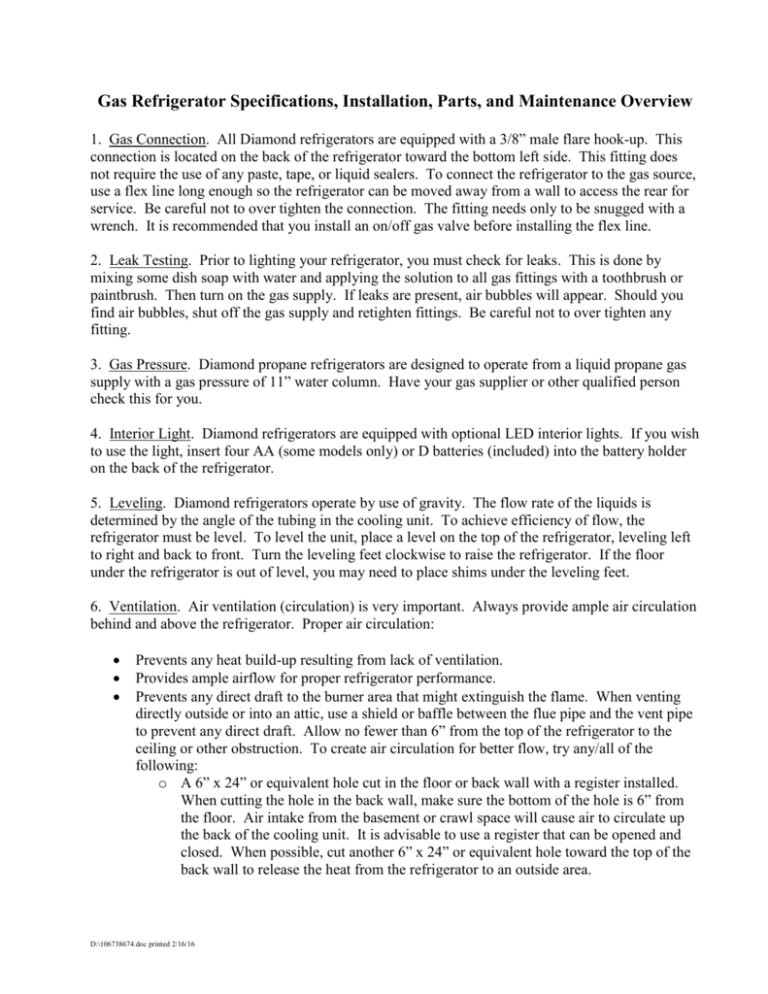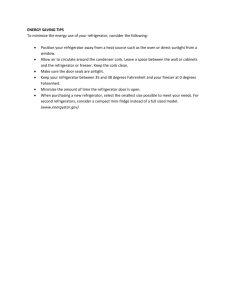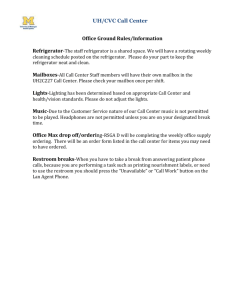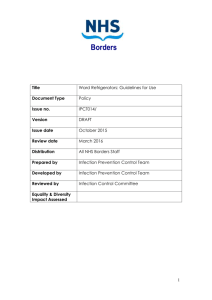Gas Refrigerator Specifications, Installation, Parts, and Maintenance
advertisement

Gas Refrigerator Specifications, Installation, Parts, and Maintenance Overview 1. Gas Connection. All Diamond refrigerators are equipped with a 3/8” male flare hook-up. This connection is located on the back of the refrigerator toward the bottom left side. This fitting does not require the use of any paste, tape, or liquid sealers. To connect the refrigerator to the gas source, use a flex line long enough so the refrigerator can be moved away from a wall to access the rear for service. Be careful not to over tighten the connection. The fitting needs only to be snugged with a wrench. It is recommended that you install an on/off gas valve before installing the flex line. 2. Leak Testing. Prior to lighting your refrigerator, you must check for leaks. This is done by mixing some dish soap with water and applying the solution to all gas fittings with a toothbrush or paintbrush. Then turn on the gas supply. If leaks are present, air bubbles will appear. Should you find air bubbles, shut off the gas supply and retighten fittings. Be careful not to over tighten any fitting. 3. Gas Pressure. Diamond propane refrigerators are designed to operate from a liquid propane gas supply with a gas pressure of 11” water column. Have your gas supplier or other qualified person check this for you. 4. Interior Light. Diamond refrigerators are equipped with optional LED interior lights. If you wish to use the light, insert four AA (some models only) or D batteries (included) into the battery holder on the back of the refrigerator. 5. Leveling. Diamond refrigerators operate by use of gravity. The flow rate of the liquids is determined by the angle of the tubing in the cooling unit. To achieve efficiency of flow, the refrigerator must be level. To level the unit, place a level on the top of the refrigerator, leveling left to right and back to front. Turn the leveling feet clockwise to raise the refrigerator. If the floor under the refrigerator is out of level, you may need to place shims under the leveling feet. 6. Ventilation. Air ventilation (circulation) is very important. Always provide ample air circulation behind and above the refrigerator. Proper air circulation: Prevents any heat build-up resulting from lack of ventilation. Provides ample airflow for proper refrigerator performance. Prevents any direct draft to the burner area that might extinguish the flame. When venting directly outside or into an attic, use a shield or baffle between the flue pipe and the vent pipe to prevent any direct draft. Allow no fewer than 6” from the top of the refrigerator to the ceiling or other obstruction. To create air circulation for better flow, try any/all of the following: o A 6” x 24” or equivalent hole cut in the floor or back wall with a register installed. When cutting the hole in the back wall, make sure the bottom of the hole is 6” from the floor. Air intake from the basement or crawl space will cause air to circulate up the back of the cooling unit. It is advisable to use a register that can be opened and closed. When possible, cut another 6” x 24” or equivalent hole toward the top of the back wall to release the heat from the refrigerator to an outside area. D:\106738674.doc printed 2/16/16 o Allow 11 1/2” ventilation on the top, 3” on the sides, and 2” from the back of the refrigerator to the wall for additional air circulation. It is recommended that the refrigerator be installed free standing. o Venting the flue pipe directly outside or into an attic or similar plumbing as required by a water heater will rid the area of most of the heat produced by a refrigerator. Do not make a sealed connection between the flue and vent pipe connection. Simply hover the vent pipe over the flue pipe, allowing some air to draft in, creating a good airflow. o If circulation is suspected to be inadequate, roll the refrigerator away from the walls and other obstructions and let it run for a while. If the refrigerator compartment temperature lowers drastically while in the unobstructed position, the air circulation in the intended location is inadequate. D:\106738674.doc printed 2/16/16






